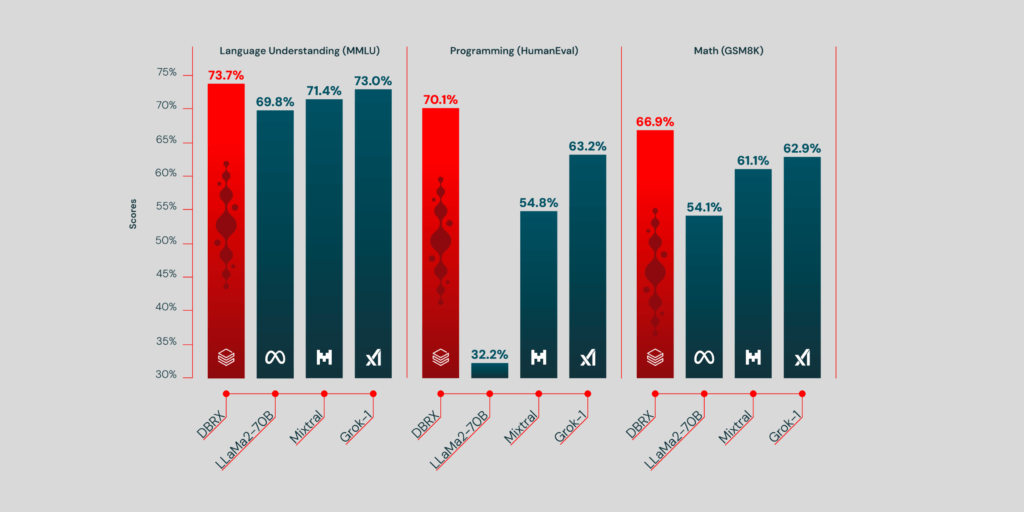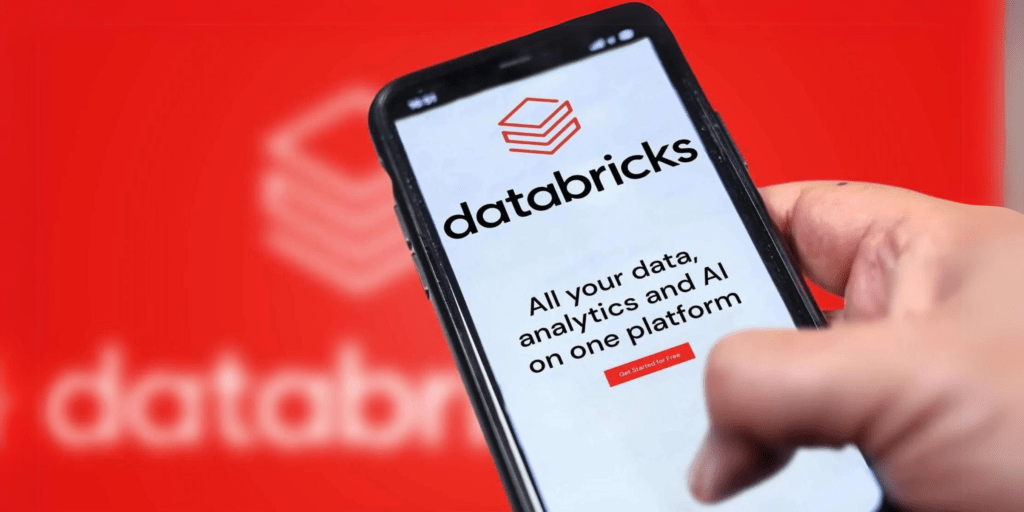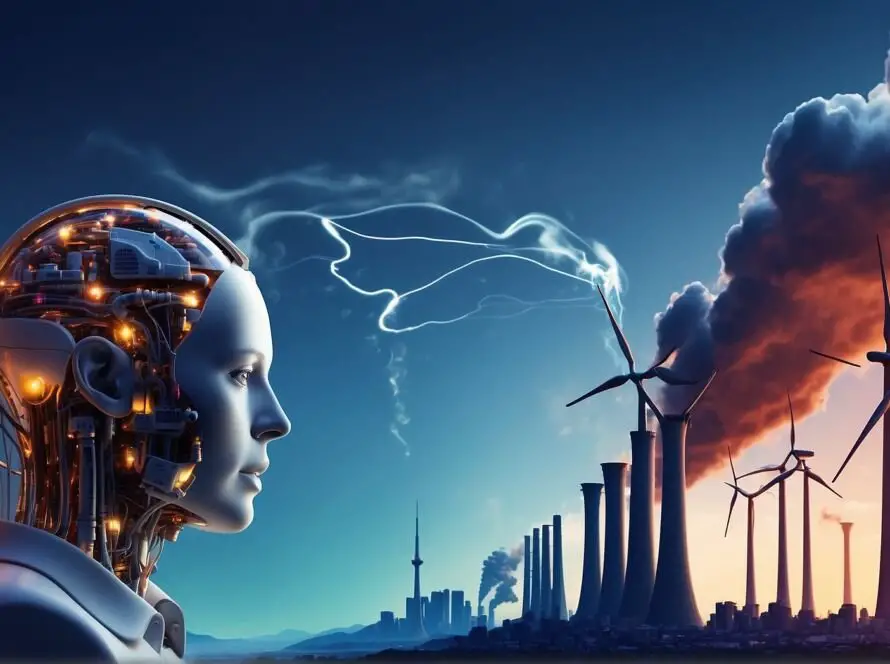Artificial intelligence, the race to develop the most advanced and efficient large language models, has been primarily dominated by proprietary technologies.
A significant shift is underway, marked by the latest milestone from Databricks, a leader in data science and AI innovation. On March 27, 2024, Databricks unveiled DBRX, the world’s most powerful open-source LLM, setting a new benchmark in the AI community.
This groundbreaking development not only challenges the status quo of AI advancements but also democratizes access to cutting-edge AI technologies for enterprises worldwide.
DBRX’s release is the culmination of months of rigorous development involving a dedicated team of engineers and executives who invested approximately $10 million into the project.
Their goal was clear to create an AI model that not only rivals but surpasses the capabilities of existing open-source models, including Meta’s Llama 2 and even proprietary models like OpenAI’s GPT-3.5, in various standard industry benchmarks.
The success of DBRX represents a pivotal moment in AI, as it embodies Databricks’ vision to democratize data and AI, enabling organizations to harness their private data to build bespoke AI systems.
The introduction of DBRX into the market is a testament to the power of open-source innovation in accelerating the development and adoption of AI technologies. It signifies a shift towards more accessible, customizable, and efficient AI solutions that promise to reshape the landscape of AI applications across industries.
As we delve into the details of DBRX’s creation, capabilities, and potential impact, it’s clear that Databricks’ latest achievement is not just a technological triumph but a step towards a future where the benefits of AI are within reach of every enterprise, regardless of their size or resources.
The Creation of DBRX
The journey to create DBRX, the most powerful open-source large language model to date, represents a blend of ambition, technical innovation, and collaborative effort spearheaded by Databricks, a renowned data science and AI company.
The narrative of DBRX’s development underscores a strategic endeavor aimed at pushing the boundaries of what open-source AI models can achieve, both in terms of performance and accessibility.
This section delves into the conceptualization, development process, and architectural innovations that underpin DBRX.
Databricks embarked on the DBRX project with a visionary aim: to democratize the field of AI by offering an open-source large language model that could rival, and even surpass, the capabilities of proprietary models like GPT-3.5 and established open-source counterparts such as Llama 2.
The inception of DBRX was motivated by the desire to provide enterprises with the tools to harness their data for building custom AI solutions without being tethered to the limitations of closed models.
The creation of DBRX was a meticulously planned and executed project that spanned several months, involving a dedicated team of approximately a dozen engineers and executives.
With a budget of about $10 million, the team embarked on a rigorous training regime, leveraging the latest advancements in AI research and computational resources.
The project utilized NVIDIA DGX Cloud for training. It capitalized on its powerful computing capabilities to process vast datasets and refine the model’s learning outcomes.
A pivotal aspect of DBRX’s development was the adoption of a mixture-of-experts architecture. This decision set DBRX apart from conventional large language models. This architecture enabled DBRX to achieve unparalleled efficiency and speed, making it not only more powerful but also more cost-effective in terms of compute resources.
The MoE approach allows DBRX to dynamically allocate computational effort to the most relevant parts of the model for a given task, enhancing its performance on a wide range of benchmarks, including language understanding, programming, math, and logic.
By integrating MoE with the MegaBlocks open-source project, Databricks optimized DBRX for high performance and computational efficiency.
This innovative architecture underpins DBRX’s leading performance metrics, as evidenced by its superior results on standard industry benchmarks against both open-source and proprietary competitors.
The architectural choices made in the development of DBRX not only underscore its technical prowess but also reflect Databricks’ commitment to open-source principles.
By leveraging the mixture-of-experts architecture and building upon the MegaBlocks project, Databricks has positioned DBRX as a model that combines leading-edge performance with the principles of transparency, accessibility, and customization.
This approach not only sets a new standard for open-source LLMs but also paves the way for a more inclusive and innovative future in AI development.

DBRX vs. Other Models
The advent of DBRX by Databricks represents a significant leap in the field of artificial intelligence, particularly in the development and deployment of large language models.
Its introduction into the open-source community marks a pivotal moment, setting new standards for performance, efficiency, and accessibility. This section compares DBRX against existing open-source models like Llama 2 and proprietary models such as GPT-3.5, highlighting the distinctions that set DBRX apart in the competitive landscape of AI technologies.
DBRX’s entry into the market is characterized by its exceptional performance across a variety of standard industry benchmarks, significantly outperforming its predecessors and contemporaries in tasks related to language understanding, programming, math, and logic.
Notably, DBRX eclipses established open source models like Llama 2 70B and Mixtral-8x7B, as well as surpassing the capabilities of GPT-3.5, a proprietary model by OpenAI, in these critical areas.
This achievement underscores the technical advancements and the quality of innovation embedded within DBRX, establishing it as a leader in the AI domain.
One of the key differentiators for DBRX is its mixture-of-experts architecture, which stands at the core of its enhanced performance and efficiency. Unlike traditional models that utilize a more uniform computational approach across tasks, DBRX dynamically allocates computational resources to the most relevant “experts” for any given task.
This results in a model that is not only faster in terms of tokens processed per second but also more cost-effective to serve, offering significant advantages over models built on conventional architectures.
Beyond the technical metrics where DBRX outshines its competitors, its open-source nature represents a broader shift towards the democratization of AI technologies.
By offering an open-source model that rivals or exceeds the performance of proprietary models, Databricks is enabling organizations of all sizes to build, train, and serve their own custom LLMs.
This move is expected to accelerate the trend of organizations replacing proprietary models with open-source alternatives, fostering an environment of innovation and accessibility in AI development.
DBRX’s performance and architectural advantages facilitate a wide range of enterprise applications, from enhancing coding assistance tools to improving natural language understanding systems.
The model’s efficiency and adaptability make it particularly appealing for businesses looking to tailor AI solutions to their specific needs while maintaining control over their data and intellectual property.
This capability is a significant departure from the limitations associated with using closed-source models, which often restrict customization and data governance.
The introduction of DBRX not only sets a new benchmark in the AI field but also signals a future where open-source models play a pivotal role in the development and deployment of AI technologies.
As enterprises and developers embrace DBRX for its performance, efficiency, and flexibility, we are likely to see a surge in innovative AI applications that leverage the unique capabilities of this model.
The shift towards open source is not just a trend but a transformation in how AI technologies are developed, deployed, and democratized, with DBRX leading the charge.
Open-Source Impact and Implications
DBRX represents a significant step forward in the democratization of AI technologies. By outperforming existing open source and proprietary models on various benchmarks, DBRX provides enterprises of all sizes with the tools to harness advanced AI capabilities without the prohibitive costs and restrictions often associated with proprietary models.
This leveling of the playing field enables a wider range of organizations to develop custom AI solutions tailored to their unique needs, thereby expanding the reach and benefits of AI across the economy.
The release of DBRX is expected to accelerate the trend of organizations shifting from proprietary to open-source AI models. The model’s superior performance, coupled with its efficiency and cost-effectiveness, makes a compelling case for enterprises to adopt open-source alternatives.
This shift is likely to spur further innovation in the open-source AI space as more organizations contribute to and build upon the foundations laid by models like DBRX.
The move towards open source not only fosters a collaborative environment for AI development but also challenges the dominance of a few proprietary models, encouraging diversity and competition in the AI landscape.
DBRX’s innovative architecture and leading performance metrics set new benchmarks for AI research and development.
The model’s mixture-of-experts architecture, in particular, showcases the potential for novel approaches to model design and optimization, offering valuable insights for future AI research.
DBRX’s success underscores the importance of open source projects in driving forward the state of the art in AI, suggesting that collaborative and transparent development efforts can yield technologies that rival or surpass those developed in more closed environments.
The practical implications of DBRX for industry and enterprise applications are profound. Organizations now have access to a powerful tool that can be customized for a wide range of uses, from enhancing natural language processing capabilities to automating complex workflows.
This access supports innovation, efficiency, and competitive advantage across sectors, enabling businesses to leverage AI in ways that were previously inaccessible.
DBRX’s open-source nature ensures that enterprises can maintain control over their data and AI solutions, addressing concerns related to data privacy, security, and governance.
The democratization of AI through technologies like DBRX also brings ethical and social considerations to the forefront. As AI becomes more accessible, ensuring responsible use, addressing biases, and safeguarding against misuse become paramount.
The open-source community, including projects like DBRX, plays a critical role in fostering discussions around ethical AI development and use, encouraging a culture of transparency, accountability, and inclusivity in the AI ecosystem.
Applications and Adoption
The unveiling of DBRX by Databricks marks a significant advancement in the field of artificial intelligence, offering a potent open-source large language model that stands to revolutionize how businesses and organizations leverage AI technologies.
Its superior performance, combined with the flexibility and efficiency offered by its architecture, positions DBRX as a catalyst for widespread adoption across various industries.
This section explores potential applications and adoption scenarios for DBRX, illustrating its versatility and transformative potential.
DBRX’s proficiency in understanding and generating programming code can significantly enhance developer tools, making coding more efficient and accessible.
By integrating DBRX into integrated development environments or as part of automated code review systems, organizations can streamline development workflows, reduce bugs, and lower the barrier to entry for coding.
This application is particularly beneficial for rapidly growing sectors that demand quick development cycles and high-quality software products.
With its advanced language understanding capabilities, DBRX is well-suited for a wide range of NLP applications, including chatbots, virtual assistants, and customer service automation.
Businesses can leverage DBRX to create more responsive and intuitive AI-driven interfaces, improving customer interactions and satisfaction.
DBRX’s ability to handle complex language tasks makes it an ideal solution for content generation, summarization, and translation services.
DBRX has the potential to revolutionize educational software and online learning platforms by providing personalized learning experiences and automating administrative tasks.
Its ability to generate educational content, quizzes, and even programming exercises can support educators in creating more engaging and tailored learning materials.
DBRX can assist in grading and providing feedback on assignments, thereby enhancing the efficiency of educational institutions and e-learning platforms.
Researchers across various domains can benefit from DBRX’s capacity for natural language understanding and generation to sift through vast amounts of literature, summarize findings, and even generate hypotheses.
This application is particularly valuable in fields where staying abreast of the latest research findings is crucial. Additionally, DBRX can aid in data analysis tasks, interpreting complex datasets, and generating reports, making it a valuable tool for scientists and analysts.
In the healthcare sector, DBRX can support clinical decision-making by analyzing medical literature, patient records, and research data to provide insights and recommendations.
Its ability to process and generate natural language can also improve patient interactions through virtual health assistants, offering personalized advice and support. DBRX’s capabilities can streamline administrative tasks, such as documentation and reporting, enhancing operational efficiency in healthcare settings.
The creative potential of DBRX can be harnessed in industries such as advertising, marketing, and entertainment, where generating original content is key.
From crafting compelling marketing copy to generating scripts and storylines, DBRX can support creative professionals by automating aspects of the creative process, allowing for more focus on strategic and innovative work.
Enterprises are poised to adopt DBRX to enhance their AI-driven applications and services, given its versatility and performance. Adoption is facilitated by Databricks’ ecosystem, which offers tools and platforms for integrating DBRX into existing workflows and systems.
Organizations can leverage DBRX to develop bespoke AI solutions that align with their specific needs and objectives, ensuring they remain at the forefront of innovation in their respective industries.

Availability and Future Prospects
The release of DBRX by Databricks represents a significant milestone in the democratization of artificial intelligence technology. Its availability as an open-source large language model and its superior performance characteristics make it a game-changer in the AI community.
This section explores the availability of DBRX across various platforms and its implications for future developments in AI technologies.
DBRX is made freely available on prominent repositories and platforms, such as GitHub and Hugging Face, for both research and commercial use.
This strategic decision by Databricks ensures that the model is accessible to a wide audience, including researchers, developers, and enterprises, facilitating innovation and encouraging widespread adoption.
DBRX is integrated into the Databricks Platform, enabling users to leverage its capabilities within a comprehensive data intelligence environment. The model is also available on major cloud platforms like AWS, Google Cloud, and directly on Microsoft Azure through Azure Databricks, ensuring that organizations can easily incorporate DBRX into their existing cloud infrastructure.
The expected availability of DBRX through the NVIDIA API Catalog and support on the NVIDIA NIM inference microservice highlights the model’s compatibility with leading-edge hardware and software ecosystems.
This integration not only emphasizes the model’s computational efficiency but also points to future developments where AI models like DBRX could be further optimized for performance on specialized hardware.
The launch of DBRX sets a new standard for open-source LLMs, potentially accelerating the trend toward more transparent, collaborative, and accessible AI development.
As organizations and individual developers experiment with and build upon DBRX, the AI community is likely to see an influx of innovative applications and improvements to the model. This open-source approach fosters a culture of sharing and collaboration, which is essential for addressing complex challenges in AI research and development.
The availability of DBRX opens up new avenues for AI research, particularly in areas where access to high-quality LLMs was previously limited by cost or proprietary restrictions.
Researchers can now explore novel applications, conduct comparative studies, and contribute to the enhancement of the model itself. This could lead to significant advancements in natural language processing, machine learning, and other AI disciplines.
With the power and potential of DBRX comes the responsibility to ensure its ethical use and to mitigate risks associated with AI technologies.
Databricks and the broader AI community are challenged to address issues of bias, privacy, and security in continuous development efforts.
The open-source nature of DBRX encourages transparency and accountability, allowing for broader scrutiny and contributions toward more ethical and responsible AI systems.
The future of DBRX and similar open-source AI projects will heavily depend on the active participation and collaboration of the global AI community.
Contributions from academia, industry, and independent developers will be crucial for improving the model, expanding its applications, and ensuring its responsible use. The shared commitment to open-source principles is expected to drive innovation and ethical standards in AI development.

Final Thoughts
The launch of DBRX by Databricks heralds a new era in the field of artificial intelligence, setting a benchmark for open-source large language models through its unmatched performance, efficiency, and flexibility.
This pivotal development is not just a testament to the technical prowess embedded within DBRX but also reflects a broader movement towards democratizing AI technologies, making them accessible and customizable for organizations and developers across the globe.
DBRX’s superiority over existing models in various benchmarks, coupled with its innovative mixture-of-experts architecture, positions it as a formidable tool in the AI landscape.
Its ability to outperform established open-source models and even proprietary models like GPT-3.5 on key metrics underscores the potential for open-source initiatives to drive forward the state of the art in AI.
DBRX’s commitment to open-source principles catalyzes a shift in how AI development is approached, promoting transparency, collaboration, and inclusivity.
The wide range of applications and sectors that stand to benefit from DBRX—from software development and natural language processing to healthcare and education—illustrates the model’s versatility and transformative potential.
As organizations begin to adopt and integrate DBRX into their operations, we can expect a surge in innovation, efficiency, and new capabilities that were previously unattainable or cost-prohibitive.
Looking ahead, the future of DBRX and similar open-source AI projects will hinge on continuous collaboration within the global AI community. The shared contributions, improvements, and ethical considerations around the use of such technologies will shape the trajectory of AI development.
With DBRX, Databricks not only delivers a cutting-edge tool for today’s AI challenges but also lays the groundwork for a more open, equitable, and innovative future in artificial intelligence.


